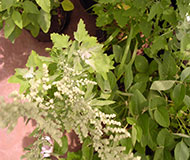Australian Journal of Botany
Volume 67
Number 2 2019
Viola banksii occurs exclusively in Australian flora and is a type species of the native, Australian Erpetion section of the genus Viola. Some traits described in these studies are new for the Viola genus and could be unique for the Erpetion section. The Australian flora is particularly interesting for the study of evolution because of its long isolation from other continental floras, the high degree of endemism, and its distinctive character.
Quantitative relationship between plant growth and allocation to reproductive structures was allometrically studied in four annual weed species. Linear regressions fitted for plant biomass/seed number relationships in Digitaria sanguinalis, Setaria verticillata, Chenopodium album and Amaranthus hybridus differed consistently in the pattern of reproductive allocation given by the slope of the models. The linear models fitted for the first three species had the same intercept close to zero (y-axis intercept when x = 0 was zero). Distinctly, Amaranthus hybridus reproductive allocation changed allometrically under highly competitive stress since small plants failed to set seeds, unless a plant biomass threshold was attained (x-axis intercept when y = 0 was positive).
Optimising climate resilience of restoration efforts requires an understanding of a species response to certain environmental constraints. By exploring the variation in germination in stored seeds from multiple populations of the native grass Neurachne alopecuroidea, we found that germination speed and success declined with decreasing moisture availability, with greater impact at higher temperatures. The considerable variation in germination response across the species Western Australian distribution suggests that some sites may be better seed sources for future restoration than others.
Contributions of birds and small, non-flying mammals to pollination and reproductive output of the South African endemic Aloe peglerae, were compared between good and poor flowering years using remote camera traps. Birds are the aloes’ primary pollinators, but moved to better nectar resources in the poor flowering year, and less mobile small mammals (e.g. mice and sengi) acted as suitable, alternative pollinators for the critically endangered aloe species.
A phylogeography study of Amygdalus mongolica in northwest China revealed the influence of complicated paleogeologic and paleoclimatic events upon genetic differentiation and the evolutionary history of this species during the Pleistocene. Significant genetic differentiation among populations was identified. This resulted from fragmented populations coupled with the enhanced aridification and desertification of the Pleistocene. Results of this study have implications for the evolution of other desert plants in northwest China.
The dynamics of cell wall composition has a key role in structural and functional establishment of tissues during leaf development. We evaluated the cell wall composition of tissues in relation to cellulose, pectins and proteins in a native species of campo rupestre Neotropical vegetation, Lavoisiera mucorifera. The properties of cell wall during leaf ontogenesis influence final cell shape and tissue functionality, acting as a parameter to identify the stages of development.
The underlying mechanisms of how and with whom plants mate intrigues evolutionary biologists. This type of research provides significant information about plant reproduction strategies. Here we provide novel data of the sexual expression and mating system of Koelreuteria elegans (family Sapindaceae). We recorded for first time in this family a constant flowering sequence female–male–female in the individual. This finding could encourage further research to broaden our understanding about evolution of sexual and mating systems in flowering plant.
Seed size and ontogenetic stage at which herbivory occurs affect the capacity of seedlings to tolerate herbivory damage. Both factors were studied in a greenhouse experiment involving seedlings of an invasive tree species in Argentina. The capacity of seedlings to tolerate herbivory was higher when damage occurred at earlier ontogenetic stages, and was positively correlated with seed size. The fact that seedlings partly compensate herbivory may be an advantage for the expansion of this exotic species.












